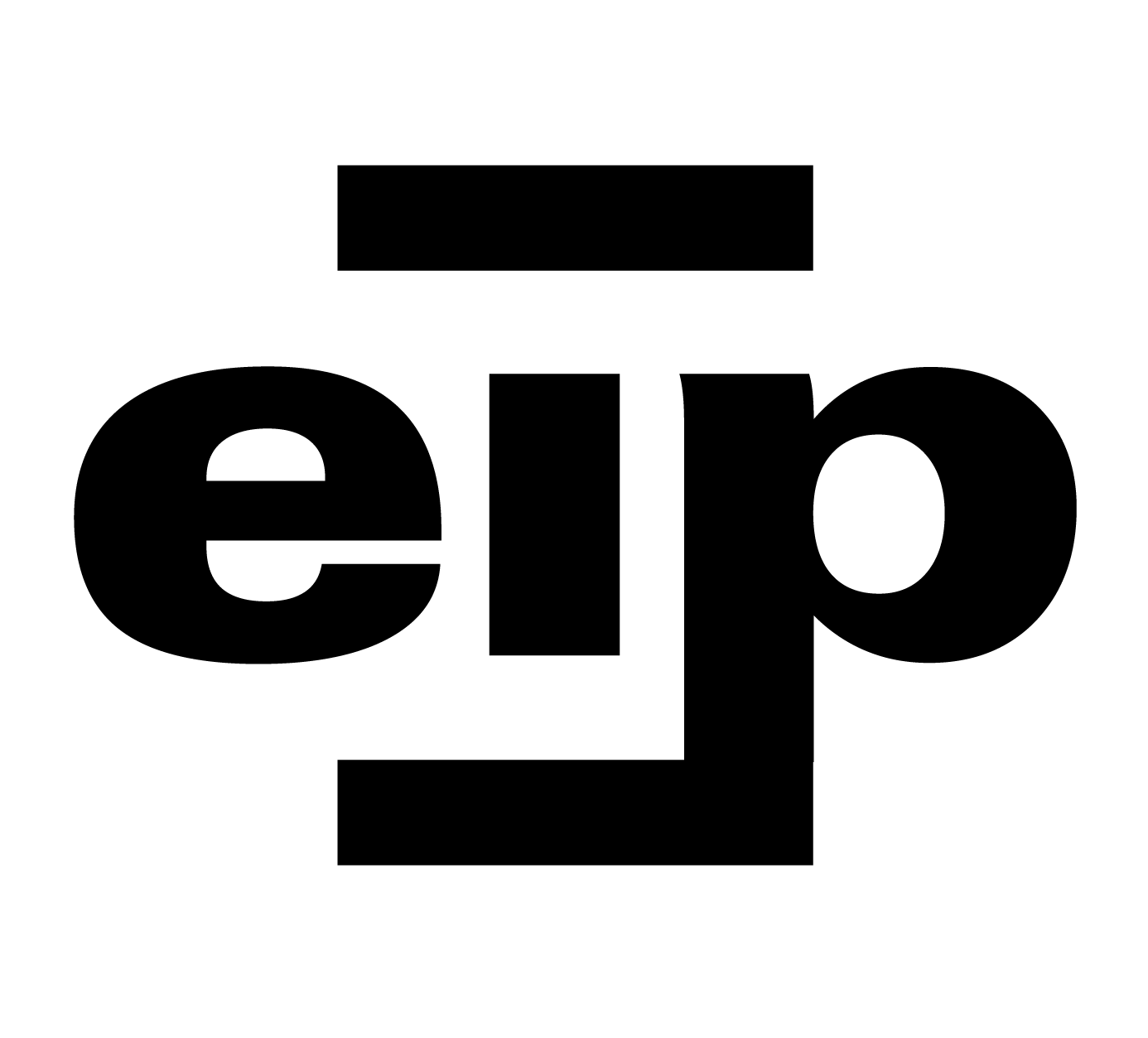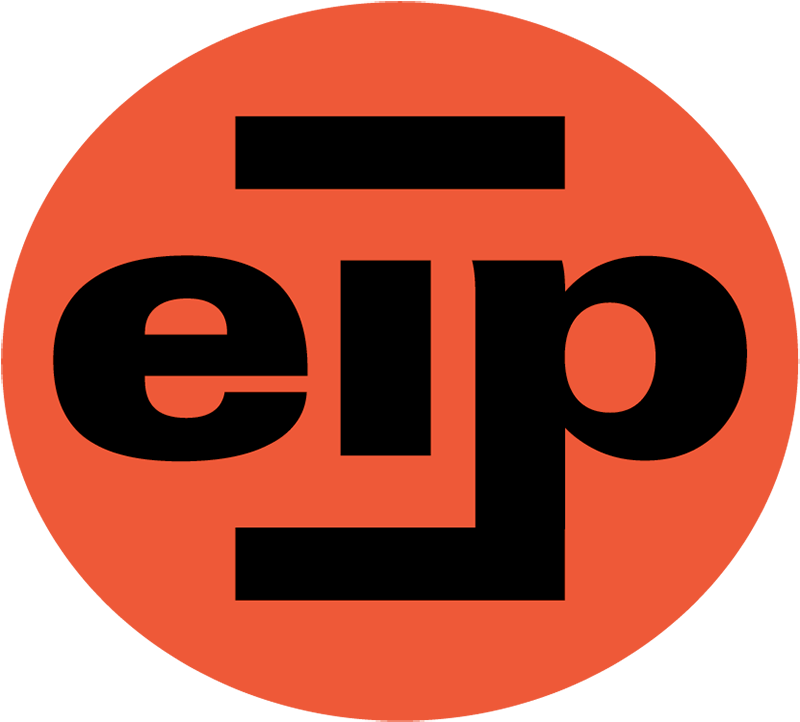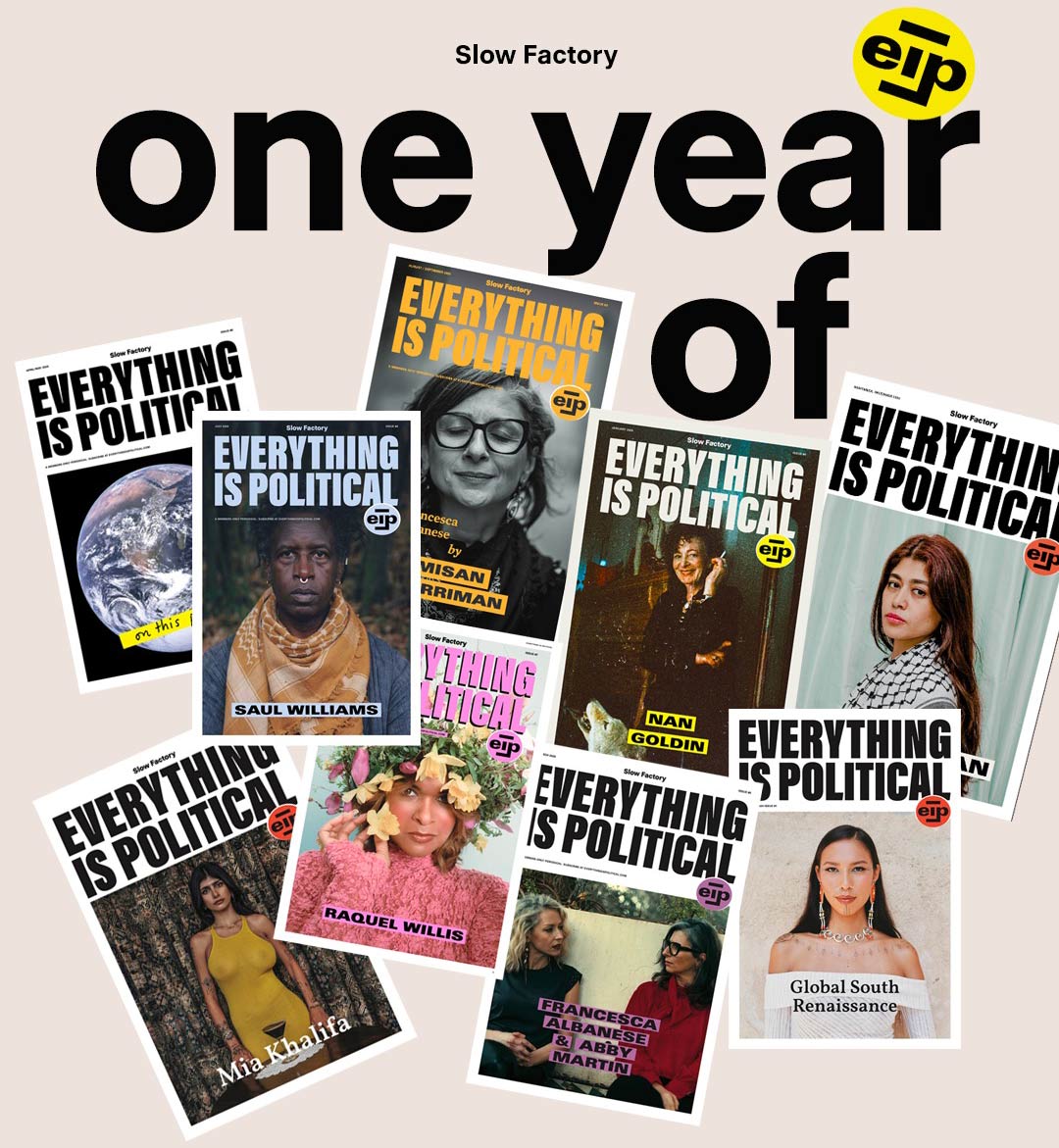Digital & Print Membership
Yearly + Receive 8 free printed back issues
$420 Annually
Monthly + Receive 3 free printed back issues
$40 Monthly
Your Nervous System under Fascism
A Decolonial Polyvagal Exploration
I never expected that a post about my nervous system’s response to fascism to blow up on Instagram.. But there I was, green tea in one hand and a lit joint in the other, watching my phone light up with hundreds of shares and DMs from therapy clients, respected educators, somatic practitioners, friends, and organizers. Even my partner, who usually avoids social media like the plague, messaged me: “OMG, this explains exactly how I feel watching the news.”
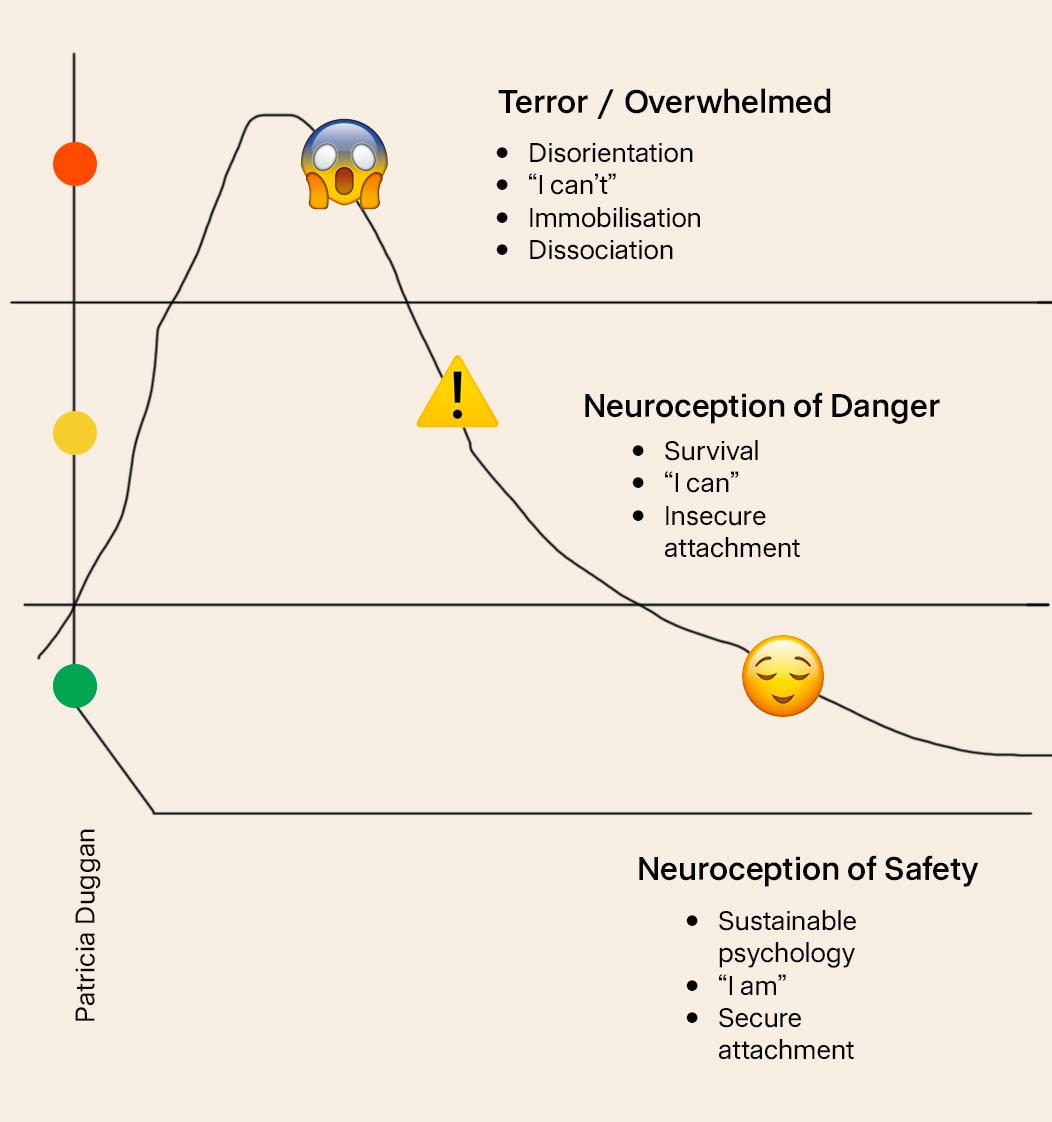
What does it mean to say fascism embeds itself in our nervous system? Through a decolonial lens and Polyvagal Theory, we’ll explore how state-manufactured fear hijacks our survival responses, and how understanding this can be a portal to healing, solidarity, and resistance.
Fear and the Polyvagal Theory 101
Polyvagal Theory, developed by neuroscientist, Stephen Porges, explains how our autonomic nervous system constantly scans for safety or danger, a subconscious process Porges calls neuroception. Depending on what we sense, we shift into different states:
Ventral Vagal (Social Engagement): the safe and connected mode when we feel secure. We can relax, think clearly, and connect with others.
Sympathetic (Fight/Flight): the alarm mode when the heart pumps and muscles tense. We are ready to confront a threat or run from it.
Dorsal Vagal (Freeze/Shutdown): the collapse mode when escape isn’t possible. We might shut down, feel numb or detached (think of a mouse playing dead).
Trauma experts also add a Fawn response: appeasing or people-pleasing to survive danger. It’s essentially “going along to get along” when facing a threat. Authoritarian systems encourage fawning compliance. As one writer, D.L. Mayfield, quipped, “The fawn response is the desired threat response for authoritarian parents, religious leaders, and governments.” In other words, oppressive regimes love people who have learned to freeze or submit rather than fight back.
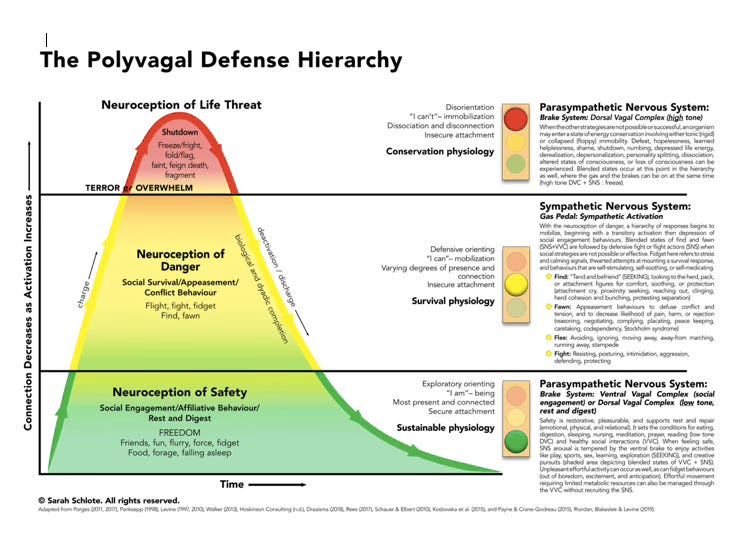 Polyvagal Defense Hierarchy
Polyvagal Defense Hierarchy
Authoritarianism Hijacks Our Survival Responses
Authoritarian leaders know fear is a powerful political weapon. They flood the environment with cues of danger—terrorism, “invaders,” moral panic—that our neuroception reads as threats. Even if we aren’t consciously aware, our bodies react: muscles tense, hearts race, or a numb pit develops in the stomach.
Porges notes that when we perceive someone as dangerous (whether true or not), our nervous system automatically launches into defensive behaviors like fight, flight or freeze.
Real-world examples are everywhere.
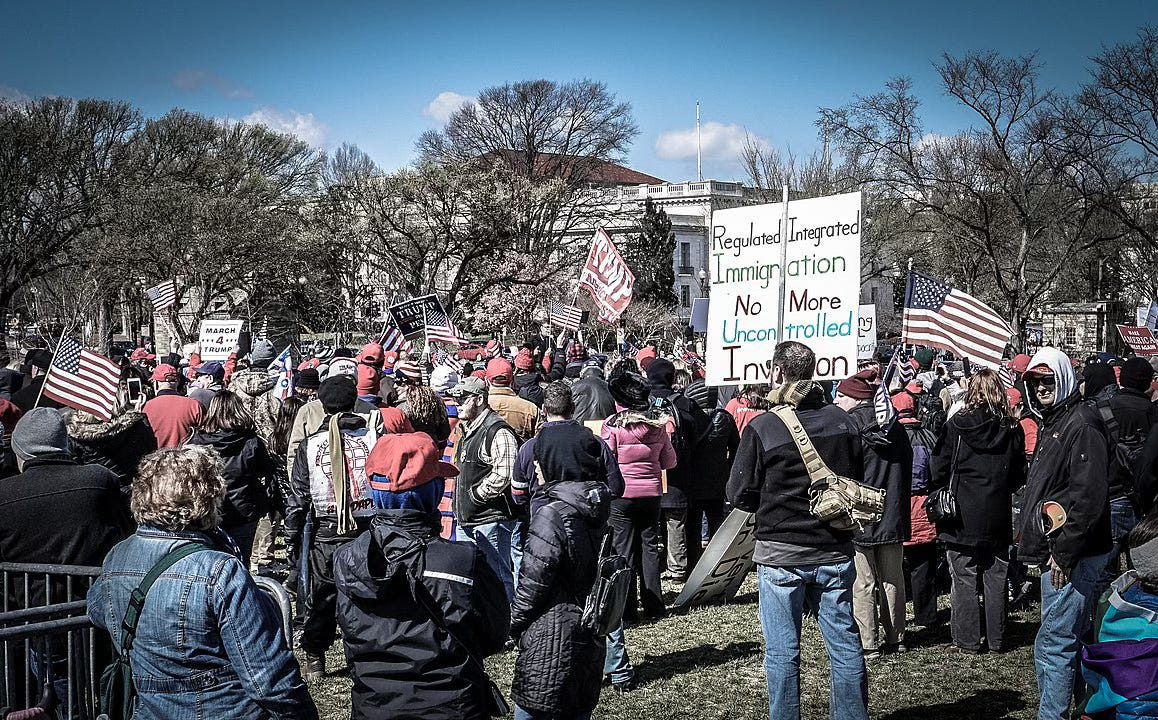 Pro-Donald Trump rally in Washington, D.C. March 2017 (Wikicommons)
Pro-Donald Trump rally in Washington, D.C. March 2017 (Wikicommons)
Donald Trump’s political return has been fueled by classic fear-mongering—portraying immigrants, dissidents, and the media as threats. This rhetoric pushes supporters into a chronic fight/flight state of anger and vigilance, while those targeted (immigrants, journalists) may experience terror or shutdown. A similar dynamic unfolds with anti-trans legislation in the so-called United States: lawmakers invoke fear to justify stripping away trans rights, which not only rallies some people’s fight response against a scapegoated group, but also forces trans folks into constant survival mode, scanning for danger and often fawning or hiding their true selves to stay safe.
Police violence against Black and Brown communities likewise keeps entire populations on high alert. For instance, a routine traffic stop can trigger intense flight/freeze reactions in people of color who have learned through lived experience (and generations of history) that such encounters can be life-threatening. Far-right movements from Europe to South America follow the same script: stoke fear of “others,” activate people’s survival instincts, and then promise order and security in exchange for obedience. It’s a vicious cycle. Fear is used to justify authoritarian control, and authoritarianism, in turn, creates more fear.
Trauma Responses: Wisdom, Not Weakness (A Decolonial View)
It’s vital to remember that trauma responses—fight, flight, freeze, fawn—are not personal failures. They are our bodies’ wise attempts to protect us. Somatic Practitioner and Licensed Clinical Social Worker, Resmaa Menakem, describes trauma as “a wordless story our body tells itself about what is safe and what is a threat.” If that story is shaped by constant danger, our responses reflect that. In fact, what outsiders might label “overreactions,” or even cultural stereotypes can be the result of historical trauma.
Indigenous scholars have long explained that trauma can be collective and intergenerational. Maria Brave Heart coined the term historical trauma to describe the “cumulative emotional and psychological wounding over generations” due to massive group traumas like colonization. Eduardo Duran, a Native psychologist, calls this the “soul wound,” a deep injury inflicted by colonization that gets passed down. He writes that “internalized oppression is a wound that, like a vampire bite, becomes embedded” in the people who experience abuse. In other words, when communities endure generations of violence and fear, they may carry the imprint of the oppressor in their own nervous systems.
What looks like freeze or fawn today may have its roots in what helped your ancestors survive. Menakem notes that after centuries of brutalization, our ancestors “stored trauma and intense survival energy, and passed these on to our children and grandchildren.” Seen this way, a community’s hyper-vigilance or tendency to withdraw isn’t weakness, it’s collective survival—wisdom born of living under attack.
A decolonial lens reminds us that Western psychology is only catching up to what Indigenous peoples have known: trauma is not just individual, and healing must be collective.
From Survival to Solidarity: Healing and Action
Understanding all this isn’t just an intellectual exercise, it’s a call to action. If fascism works by keeping us in survival mode, then one radical act is to reclaim our ventral vagal (safe and social) state. In practical terms, this means deliberately fostering safety, connection, and community.
Trauma specialist, Deb Dana, suggests that we can “stand up for what we believe in… from a place of regulation rather than from a state of protection.” In other words, when we feel grounded and safe in our bodies, we can respond to injustice with courage and creativity instead of reacting out of fear. Activist healers like Menakem even argue that activism can be a form of healing, an opportunity to process pain through action and break the cycles of trauma.
So, how do we get there? We start by befriending our nervous systems. We practice noticing whether we are in fight, flight, freeze, or fawn. We offer our bodies safety through breath, movement, reaching out to a friend, or remembering that we are not alone. Authoritarians want us to feel isolated and afraid. We subvert them by connecting and sharing our stories, honoring ancestral resilience, and co-creating pockets of safety and solidarity. A community drum circle, a protest rally that feels like a family gathering, a mutual aid network; these are acts of resistance as much as any policy fight. They help shift us (and those around us) out of fear and into the ventral vagal state of grounded power. From there, we can imagine and build societies that don’t run on fear, but on justice and care.
Call to Action: Our Bodies Remember, but They Can Also Re-learn
By recognizing how fascist systems trigger our deepest survival wiring, we can choose to do the opposite. We can create environments of safety that empower people rather than terrify them. This might mean educating our communities about trauma, holding space for collective grief and healing, or simply checking in with yourself and neighbors in these turbulent times. When we soothe our nervous systems, we don’t just feel better, we think more clearly and organize more effectively and efficiently. The more people operating from calm connection (instead of panic or shutdown), the more difficult it is for fear-based politics to take hold. Healing is a form of resistance. Let’s encourage one another to climb out of the survival basement and spend more time on the social roof where we can see the stars, share a meal, and plot the downfall of fear-fueled fascism together.
Reflection Questions for Grounding and Action
-
Body Check-In: When you consume news about social or political issues, what sensations do you notice in your body? Do you feel tense, numb, energized? What might this tell you about which state (fight, flight, freeze, etc.) you’re in?
-
Triggers and Ancestry: Think about a recent moment you felt fear or shut down in response to authority or conflict. How might this reaction connect to your community’s historical or ancestral experiences? (For example, what survival strategies did your parents, grandparents, or cultural group pass down?)
-
Finding Ventral Vagal: What people, places, or practices help you feel safe and connected (in a ventral vagal state)? How can you incorporate more of these in daily life, especially when fear in society is high?
-
From Reaction to Response: Recall a time you reacted in anger or froze up around an authoritarian figure or stressful event. With compassion for yourself, consider how, if you had felt more grounded or supported, you might have responded differently? What support or boundaries would help in future similar situations?
-
Collective Care: How can you contribute to a sense of safety and solidarity in your community? For instance, could you start a trauma-informed discussion group, a community care circle, or simply check on neighbors more often? Brainstorm one action that fosters connection and counters fear-based culture.
By reflecting on these questions, you’re not just intellectualizing, you’re listening to your body’s wisdom and taking steps toward healing in community. This is how we immunize ourselves against the lure of fascist fear. Together, rooted in safety and justice, we can break the trauma cycle and chart a new path forward.
Sources:
- Dana, D. (2018). The polyvagal theory in therapy: Engaging the rhythm of regulation. W. W. Norton & Company.
- Duran, E. (2006). Healing the soul wound: Counseling with American Indians and other Native peoples. Teachers College Press.
- Menakem, R. (2017). My grandmother’s hands: Racialized trauma and the pathway to mending our hearts and bodies. Central Recovery Press.
- Porges, S. W. (2011). The polyvagal theory: Neurophysiological foundations of emotions, attachment, communication, and self-regulation. W. W. Norton & Company.
- Brave Heart, M. Y. H. (2003). The historical trauma response among natives and its relationship with substance abuse: A Lakota illustration. Journal of Psychoactive Drugs, 35(1), 7–13. https://doi.org/10.1080/02791072.2003.10399988
{
"article":
{
"title" : "Your Nervous System under Fascism: A Decolonial Polyvagal Exploration",
"author" : "Patricia Duggan",
"category" : "essays",
"url" : "https://everythingispolitical.com/readings/your-nervous-system-under-fascism-a-decolonial-polyvagal-exploration",
"date" : "2025-05-15 15:07:00 -0400",
"img" : "https://everythingispolitical.com/uploads/2025_05_21_EIP_Nervous_System_5.jpg",
"excerpt" : "I never expected that a post about my nervous system’s response to fascism to blow up on Instagram.. But there I was, green tea in one hand and a lit joint in the other, watching my phone light up with hundreds of shares and DMs from therapy clients, respected educators, somatic practitioners, friends, and organizers. Even my partner, who usually avoids social media like the plague, messaged me: “OMG, this explains exactly how I feel watching the news.”",
"content" : "I never expected that a post about my nervous system’s response to fascism to blow up on Instagram.. But there I was, green tea in one hand and a lit joint in the other, watching my phone light up with hundreds of shares and DMs from therapy clients, respected educators, somatic practitioners, friends, and organizers. Even my partner, who usually avoids social media like the plague, messaged me: “OMG, this explains exactly how I feel watching the news.”What does it mean to say fascism embeds itself in our nervous system? Through a decolonial lens and Polyvagal Theory, we’ll explore how state-manufactured fear hijacks our survival responses, and how understanding this can be a portal to healing, solidarity, and resistance.Fear and the Polyvagal Theory 101Polyvagal Theory, developed by neuroscientist, Stephen Porges, explains how our autonomic nervous system constantly scans for safety or danger, a subconscious process Porges calls neuroception. Depending on what we sense, we shift into different states:Ventral Vagal (Social Engagement): the safe and connected mode when we feel secure. We can relax, think clearly, and connect with others.Sympathetic (Fight/Flight): the alarm mode when the heart pumps and muscles tense. We are ready to confront a threat or run from it.Dorsal Vagal (Freeze/Shutdown): the collapse mode when escape isn’t possible. We might shut down, feel numb or detached (think of a mouse playing dead).Trauma experts also add a Fawn response: appeasing or people-pleasing to survive danger. It’s essentially “going along to get along” when facing a threat. Authoritarian systems encourage fawning compliance. As one writer, D.L. Mayfield, quipped, “The fawn response is the desired threat response for authoritarian parents, religious leaders, and governments.” In other words, oppressive regimes love people who have learned to freeze or submit rather than fight back.Polyvagal Defense HierarchyAuthoritarianism Hijacks Our Survival Responses Authoritarian leaders know fear is a powerful political weapon. They flood the environment with cues of danger—terrorism, “invaders,” moral panic—that our neuroception reads as threats. Even if we aren’t consciously aware, our bodies react: muscles tense, hearts race, or a numb pit develops in the stomach.Porges notes that when we perceive someone as dangerous (whether true or not), our nervous system automatically launches into defensive behaviors like fight, flight or freeze.Real-world examples are everywhere.Pro-Donald Trump rally in Washington, D.C. March 2017 (Wikicommons)Donald Trump’s political return has been fueled by classic fear-mongering—portraying immigrants, dissidents, and the media as threats. This rhetoric pushes supporters into a chronic fight/flight state of anger and vigilance, while those targeted (immigrants, journalists) may experience terror or shutdown. A similar dynamic unfolds with anti-trans legislation in the so-called United States: lawmakers invoke fear to justify stripping away trans rights, which not only rallies some people’s fight response against a scapegoated group, but also forces trans folks into constant survival mode, scanning for danger and often fawning or hiding their true selves to stay safe.Police violence against Black and Brown communities likewise keeps entire populations on high alert. For instance, a routine traffic stop can trigger intense flight/freeze reactions in people of color who have learned through lived experience (and generations of history) that such encounters can be life-threatening. Far-right movements from Europe to South America follow the same script: stoke fear of “others,” activate people’s survival instincts, and then promise order and security in exchange for obedience. It’s a vicious cycle. Fear is used to justify authoritarian control, and authoritarianism, in turn, creates more fear.Trauma Responses: Wisdom, Not Weakness (A Decolonial View)It’s vital to remember that trauma responses—fight, flight, freeze, fawn—are not personal failures. They are our bodies’ wise attempts to protect us. Somatic Practitioner and Licensed Clinical Social Worker, Resmaa Menakem, describes trauma as “a wordless story our body tells itself about what is safe and what is a threat.” If that story is shaped by constant danger, our responses reflect that. In fact, what outsiders might label “overreactions,” or even cultural stereotypes can be the result of historical trauma.Indigenous scholars have long explained that trauma can be collective and intergenerational. Maria Brave Heart coined the term historical trauma to describe the “cumulative emotional and psychological wounding over generations” due to massive group traumas like colonization. Eduardo Duran, a Native psychologist, calls this the “soul wound,” a deep injury inflicted by colonization that gets passed down. He writes that “internalized oppression is a wound that, like a vampire bite, becomes embedded” in the people who experience abuse. In other words, when communities endure generations of violence and fear, they may carry the imprint of the oppressor in their own nervous systems.What looks like freeze or fawn today may have its roots in what helped your ancestors survive. Menakem notes that after centuries of brutalization, our ancestors “stored trauma and intense survival energy, and passed these on to our children and grandchildren.” Seen this way, a community’s hyper-vigilance or tendency to withdraw isn’t weakness, it’s collective survival—wisdom born of living under attack.A decolonial lens reminds us that Western psychology is only catching up to what Indigenous peoples have known: trauma is not just individual, and healing must be collective.From Survival to Solidarity: Healing and Action Understanding all this isn’t just an intellectual exercise, it’s a call to action. If fascism works by keeping us in survival mode, then one radical act is to reclaim our ventral vagal (safe and social) state. In practical terms, this means deliberately fostering safety, connection, and community.Trauma specialist, Deb Dana, suggests that we can “stand up for what we believe in… from a place of regulation rather than from a state of protection.” In other words, when we feel grounded and safe in our bodies, we can respond to injustice with courage and creativity instead of reacting out of fear. Activist healers like Menakem even argue that activism can be a form of healing, an opportunity to process pain through action and break the cycles of trauma.So, how do we get there? We start by befriending our nervous systems. We practice noticing whether we are in fight, flight, freeze, or fawn. We offer our bodies safety through breath, movement, reaching out to a friend, or remembering that we are not alone. Authoritarians want us to feel isolated and afraid. We subvert them by connecting and sharing our stories, honoring ancestral resilience, and co-creating pockets of safety and solidarity. A community drum circle, a protest rally that feels like a family gathering, a mutual aid network; these are acts of resistance as much as any policy fight. They help shift us (and those around us) out of fear and into the ventral vagal state of grounded power. From there, we can imagine and build societies that don’t run on fear, but on justice and care.Call to Action: Our Bodies Remember, but They Can Also Re-learnBy recognizing how fascist systems trigger our deepest survival wiring, we can choose to do the opposite. We can create environments of safety that empower people rather than terrify them. This might mean educating our communities about trauma, holding space for collective grief and healing, or simply checking in with yourself and neighbors in these turbulent times. When we soothe our nervous systems, we don’t just feel better, we think more clearly and organize more effectively and efficiently. The more people operating from calm connection (instead of panic or shutdown), the more difficult it is for fear-based politics to take hold. Healing is a form of resistance. Let’s encourage one another to climb out of the survival basement and spend more time on the social roof where we can see the stars, share a meal, and plot the downfall of fear-fueled fascism together.Reflection Questions for Grounding and Action Body Check-In: When you consume news about social or political issues, what sensations do you notice in your body? Do you feel tense, numb, energized? What might this tell you about which state (fight, flight, freeze, etc.) you’re in? Triggers and Ancestry: Think about a recent moment you felt fear or shut down in response to authority or conflict. How might this reaction connect to your community’s historical or ancestral experiences? (For example, what survival strategies did your parents, grandparents, or cultural group pass down?) Finding Ventral Vagal: What people, places, or practices help you feel safe and connected (in a ventral vagal state)? How can you incorporate more of these in daily life, especially when fear in society is high? From Reaction to Response: Recall a time you reacted in anger or froze up around an authoritarian figure or stressful event. With compassion for yourself, consider how, if you had felt more grounded or supported, you might have responded differently? What support or boundaries would help in future similar situations? Collective Care: How can you contribute to a sense of safety and solidarity in your community? For instance, could you start a trauma-informed discussion group, a community care circle, or simply check on neighbors more often? Brainstorm one action that fosters connection and counters fear-based culture. By reflecting on these questions, you’re not just intellectualizing, you’re listening to your body’s wisdom and taking steps toward healing in community. This is how we immunize ourselves against the lure of fascist fear. Together, rooted in safety and justice, we can break the trauma cycle and chart a new path forward.Sources: Dana, D. (2018). The polyvagal theory in therapy: Engaging the rhythm of regulation. W. W. Norton & Company. Duran, E. (2006). Healing the soul wound: Counseling with American Indians and other Native peoples. Teachers College Press. Menakem, R. (2017). My grandmother’s hands: Racialized trauma and the pathway to mending our hearts and bodies. Central Recovery Press. Porges, S. W. (2011). The polyvagal theory: Neurophysiological foundations of emotions, attachment, communication, and self-regulation. W. W. Norton & Company. Brave Heart, M. Y. H. (2003). The historical trauma response among natives and its relationship with substance abuse: A Lakota illustration. Journal of Psychoactive Drugs, 35(1), 7–13. https://doi.org/10.1080/02791072.2003.10399988"
}
,
"relatedposts": [
{
"title" : "Mamdani & The Era of Possibilities",
"author" : "Collis Browne, Céline Semaan, EIP Editors",
"category" : "essays",
"url" : "https://everythingispolitical.com/readings/mamdani-and-the-era-of-possibilities",
"date" : "2026-01-01 12:25:00 -0500",
"img" : "https://everythingispolitical.com/uploads/zohran-inauguration-1.jpg",
"excerpt" : " What wins elections? Laser focus on challenging the brutal economic oppression that defines our global reality.",
"content" : " What wins elections? Laser focus on challenging the brutal economic oppression that defines our global reality.There is an air of undeniable hope. No matter how hard the knee-jerk catastrophic thinking might try to override with doubt, the moment is hopeful. This is proof of collective power. No matter what comes of it, we are already in a winning moment, because the people of New York city have toppled a dynasty built on greed and corruption. The entire world was inspired by this moment that was made possible by everyday people rallying together. That is how monopoly gets interrupted by people power. It’s not rocket science or AI, it’s sweat, effort, and in person collaboration.Let’s remember why this landslide engagement across political divides, why this excitement from communities and demographics who have never voted, and why this worldwide inspiration from a local election: it is a direct response to Mamdani’s laser focus on challenging the brutal economic oppression that defines our global reality.That is what wins elections; that is what inspires and unites the majority across age, ethnicity, race, and all other factors. Speaking the truth of the crushing economic reality that we live under.So now, resist the urge to follow the media’s double edge sword to fetishize and make individualized mythologies around Mamdani, his wife, the personal and aesthetic choices they are making. But continue to see them simply as people, continue to join forces with them and to remain educated, informed and most importantly not in silo but in community. Realize that we need thousands more like him who have decided that they can make a better mayor than these corrupt relics of the antiquated self-destructive past, and we need millions to always raise them up against those colluding with oligarchic corruption. And when the inevitable “fall from grace” comes, when the “media darling” moment wants to swing the other way and vilify him, resist the urge to jump on and make him any more important than but one human who wanted to make a difference in a dehumanizing system — focus on the system.Resist the urge to join in a culture war, to focus on religion or lifestyle or taste or how we spend our time as non-billionaires, and remain focused on what we can all be doing daily to gather power away from the centers of wealth and exploitation.Resist the urge to isolate in ideals, instead join the messy moment of change by being an active participant in the political spaces you wish existed.The moment calls for more action. This year, 2026, begins a new cycle filled with possibilities and people power. The moment is you. It is now. Continue to be present, be active, and take your place in making the future possible. Being an active part of your world is the antidote to the overwhelming feeling of disempowerment. The ways in which we rise, is through verbs and action. Excited to build with you all internationally and locally here in New York City. Our city."
}
,
{
"title" : "Narrative Sovereignty in the American Wing of The Met: Don't Miss ENCODED at the MET",
"author" : "",
"category" : "",
"url" : "https://everythingispolitical.com/readings/narrative-sovereignty-in-the-american-wing-of-the-met",
"date" : "2025-12-22 12:58:00 -0500",
"img" : "https://everythingispolitical.com/uploads/Cover_EIP_Hidden_Exhibition.jpg",
"excerpt" : "As artists and multicultural activists, we did not come to the Metropolitan Museum of Art’s American Wing seeking permission, instead we showed up to the work with intention, responsibility, and a commitment to truth. ENCODED: Change the Story, Change the Future exists because silence is not neutral, presence without agency is insufficient and solidarity across values-based creativity is essential for liberation.",
"content" : "As artists and multicultural activists, we did not come to the Metropolitan Museum of Art’s American Wing seeking permission, instead we showed up to the work with intention, responsibility, and a commitment to truth. ENCODED: Change the Story, Change the Future exists because silence is not neutral, presence without agency is insufficient and solidarity across values-based creativity is essential for liberation.The American Wing is often described as a celebration of American art, yet it also functions as a carefully curated archive of colonial mythology and westward expansion propaganda. Its paintings and sculptures rehearse familiar narratives: conquest framed as destiny, extraction framed as progress, whiteness framed as purity, Indigenous absence framed as inevitability. These works are not merely historical artifacts; they are instruments of narrative power. They encode ideas about belonging, legitimacy, and nationhood, ideas that continue to shape cultural consciousness and public policy today. ENCODED intervenes in this institutional space not to negate history, but to complicate it. Using augmented reality, the exhibition overlays Indigenous artistic expression and counter-narratives directly onto famous works in the American Wing, reframing them through Indigenous epistemologies, lived experience, and historical truth. This is not an act of erasure. It is an act of expansion and an overt insistence that American art history is incomplete without Indigenous voice, presence, and critique.At its core, ENCODED is grounded in the principle of narrative sovereignty. Narrative sovereignty asserts that communities most impacted by historical and ongoing harm such as Indigenous peoples, Afro-descendant people, Palestinians, Pacific Islanders, Trans folks and the working class all must have the authority to tell their own stories, in their own words, and within the institutions that have historically excluded or misrepresented them. This is not a symbolic gesture. It is a democratic imperative.Democracy depends on access to truth. When museums present a singular, sanitized vision of history, they do not merely reflect power, they reinforce it. The American Wing has long upheld myths of “taming the West” and the so-called exhaustion of empire, narratives that obscure the violence of settler colonialism, normalize Indigenous dispossession and chattel slavery. ENCODED challenges these myths by making visible what has been omitted: resistance, survival, continuity, solidarity and accountability. For me, I also hope this intervention reflects back to museum goers and viewers the perils of authoritarianism, fascism and ongoing colonial projects such as legacy media consolidation, rapid creation of datacenters to produce AI, cutting access to healthcare, education, rights, or the current US regime’s attempt to erase history by any means necessary.The artists participating in ENCODED are not responding nostalgically to the past. They are engaging the present. Their work examines how colonial narratives persist in contemporary systems including environmental destruction justified by extraction, racial hierarchies reinforced through cultural storytelling, and institutions that benefit from the aesthetics of inclusion while resisting structural change. These are not abstract critiques; they are lived realities and for me deep lessons that have been shaped by having formerly worked at a neocolonial conservation nonprofit ran by wealthy cis wyt men and their enablers for nearly five years.Artistic integrity, in this context, cannot be separated from ethical responsibility. For too long, the art world has upheld a false binary between aesthetics and politics, suggesting that rigor diminishes when artists engage power directly. ENCODED rejects this premise. Integrity is not neutrality. Integrity is the willingness to tell the truth, even when it destabilizes comfort or prestige. Walking with integrity can be painful and takes courage.Importantly, ENCODED is not positioned as a protest staged outside the institution, nor as a request for institutional validation. It is an act of presence with agency. The project uses accessible technology to meet audiences where they are, inviting participation rather than reverence. Viewers scan QR codes and encounter layered narratives that ask them to look again, listen differently, and question inherited assumptions. Except for a few organized tours, the experience is self-guided, decentralized, and deliberately democratic. It’s also fun, and it is so special to hear the familiar sounds from the ENCODED pieces ring throughout the galleries signalling that kin is close by.This kinship network and accessibility is central to the work. Cultural literacy should not be gated by academic language, curatorial authority, white exceptionalism or economic privilege. By operating through personal devices, ENCODED rejects the museum’s traditional hierarchy of knowledge and affirms that interpretation is a shared civic space. The exhibition does not dictate conclusions; it creates conditions for reckoning and deep dialogue.Solidarity is another foundational principle of the project. ENCODED brings together Indigenous artists across nations and disciplines, in relationship with Black, Brown, and allied communities who recognize that colonialism is not a single-issue structure. The logics that dispossessed Indigenous peoples are the same logics that underwrote slavery, environmental exploitation, the seizing of Palestine, forced child mining labor of cobalt in Congo and in general global empire. Working in solidarity does not collapse difference; it honors specificity while resisting division and acknowledging historic patterns of systemic oppression.In a cultural landscape shaped by scarcity and competition, ENCODED models an alternative, one rooted in collective presence, shared resources, and mutual accountability. The project refuses the extractive norms of both empire and the contemporary art economy, offering instead a relational approach grounded in care, collaboration, and long-term impact on community.The decision to situate ENCODED within the American Wing was deliberate. Indigenous art has too often been confined to anthropological contexts or framed as premodern, separate from the narrative of American art. ENCODED asserts what has always been true: Indigenous peoples are not peripheral to American history; we are foundational to it. Our stories do not belong on the margins, nor do they belong solely to the past or through a white gaze.Yet presence without counter-narrative risks assimilation. ENCODED insists that visibility must be accompanied by authorship. By intervening directly within the American Wing, the project challenges the authority of colonial framing and invites institutions to reckon with their role in shaping public memory. Our hope is that eventually the Met will see this as an opportunity to engage in discussion and support its presence well into 2026.There is risk in this work. Naming colonial propaganda within revered institutions invites discomfort, defensiveness, and critique. But risk is inseparable from integrity. Artists and cultural workers are accountable not only to institutions and audiences, but to future generations. The question is not whether institutions will change, but whether artists will continue to lead with courage when they do not.ENCODED is an offering and a provocation. It asks what it means to inherit a cultural legacy and whether we are willing to transform it. Empire is not exhausted; it is contested. And art remains one of the most powerful sites of that contestation. When we change the story, we do change the future. Not through erasure, but through expansion. Not through dominance, but through relationship.Ultimately, ENCODED affirms that art is not merely a reflection of society, but a tool for shaping it and that when artists from the margins claim space at the center, together and with integrity, we open pathways toward a more honest, inclusive, and democratic cultural future. Join us.To access ENCODED review the exhibit website for instructions. While at the Met scan the QR code and click through the prompts for the self guided tour.https://www.encodedatthemet.com"
}
,
{
"title" : "The Aesthetics of Atrocity: Lockheed Martin’s Streetwear Pivot",
"author" : "Louis Pisano",
"category" : "",
"url" : "https://everythingispolitical.com/readings/the-aesthetics-of-atrocity",
"date" : "2025-12-20 10:30:00 -0500",
"img" : "https://everythingispolitical.com/uploads/Cover_EIP_Lockheed_StreetWar.jpg",
"excerpt" : "On December 12, The Business of Fashion published an article titled “The Unlikely Rise and Uncertain Future of Lockheed Martin Streetwear,” detailing the world’s largest arms manufacturer’s entrance into casual apparel.",
"content" : "On December 12, The Business of Fashion published an article titled “The Unlikely Rise and Uncertain Future of Lockheed Martin Streetwear,” detailing the world’s largest arms manufacturer’s entrance into casual apparel.Through a licensing deal with South Korea’s Doojin Yanghang Corp., Lockheed turns fighter jet graphics, corporate slogans, and its star logo into gorpcore staples. Oversized outerwear, tactical pants, and advanced synthetic fabrics sell out at Seoul pop-ups like the Hyundai department store with young Korean consumers chasing the edgy, functional vibe. Andy Koh, a Seoul-based content creator, tells BoF that while arms manufacturing is, in theory, political, he has never encountered widespread discomfort among Korean consumers. “As long as it looks cool and the product functions as expected,” he says, “they seem okay with it.”This trend aligns with a broader South Korean fashion phenomenon: licensing logos from global non-fashion brands to create popular streetwear lines. Examples include National Geographic puffers, Yale crewnecks, Kodak retro tees, CNN hoodies, Discovery jackets, Jeep outdoor wear, and university apparel from institutions like Harvard and UCLA. These licensed collections, often featuring media, academia, sports leagues, or adventure themes, have become staples on online retailers like Musinsa and in brick-and-mortar stores, propelled by K-pop influence and a tech-savvy youth market that make these odd crossovers multimillion-dollar successes.Lockheed, however, is categorically different. Its core business is not exploration, education, or journalism. It is industrialized death, and its arrival in fashion forces a reckoning with how far commodification can stretch.Having spent years in the military, maybe I’m the wrong person to critique this. Or maybe I’m exactly the right one. I know what weapons are for, how they’re used, and the human cost they carry. Lockheed manufactures F-16 and F-35 fighter jets, Hellfire missiles, and precision-guided systems that human rights organizations have repeatedly linked to civilian casualties across multiple conflicts. In Yemen, U.S.-supplied weapons incorporating Lockheed technology contributed to thousands of civilian deaths since 2015, most notoriously the 2018 airstrike on a school bus in Saada that killed dozens of children. In Gaza, since October 2023, Lockheed-supplied F-35s and munitions have formed the backbone of air operations that Amnesty International and other watchdogs have flagged for potential violations of international humanitarian law, cases now under examination by the International Court of Justice.In 2024, the company reported $71 billion in revenue, almost entirely from military contracts, with more than 1,100 F-35s already delivered worldwide and production lines running hotter than ever. That staggering scale is the reality lurking beneath a logo now casually printed on everyday apparel.So why does the planet’s largest arms manufacturer license its brand to streetwear? The answer seems to be twofold: easy money and sophisticated image laundering. Licensing delivers low-risk royalties from Korea’s reported $35-40 billion apparel market with virtually no operational headache. Lockheed simply collects checks while a third-party manufacturer handles design, production, distribution, and deals with all the mess of retail.The far more ambitious goal, however, is reputational refurbishment. Doojin deliberately markets the line around “future-oriented technical aesthetics” and “aerospace innovation,” leaning on cutting-edge fabrics to conjure high-tech futurism instead of battlefield carnage. By late 2025, as U.S. favorability in South Korea continued to slide amid trade tensions and regional geopolitical shifts, the brand quietly de-emphasized its American roots, according to Lockheed representatives. The strategy clearly tries to sever the logo from political controversy and plant it firmly in youth culture, where aesthetic appeal routinely outmuscles ethical concern.Lockheed has honed this kind of rebranding for decades. Their corporate brochures overflow with talk of “driving innovation” and “advancing scientific discovery,” spotlighting STEM scholarships, veteran hiring initiatives, and rapid-response disaster aid. The clothing itself carries the same sanitized messaging. One prominent slogan reads “Ensuring those we serve always stay ahead of ready”, euphemistic corporate-speak that sounds heroic until you remember that “those we serve” includes forces deploying Hellfire missiles against civilian targets. Other pieces feature F-35 graphics paired with copy declaring the jet “strengthens national security, enhances global partnerships, and powers economic growth”. It’s textbook PR varnish. Instruments designed for lethal efficiency, now rebranded as symbols of progress and prosperity.We’ve also seen this trick before: Fast fashion brands that slap “sustainable” labels on sweatshop products. Tech giants that fund glamorous art installations while they harvest user data. Oil companies that rebrand themselves as forward-thinking “energy” players as the Earth’s climate burns. Lockheed, though, traffics in something uniquely irreversible: export-grade death. By licensing its identity to apparel, multibillion-dollar arms contracts are reduced to mere intellectual property; civilian casualties dissolved into, simply, background static.In other words, vibes overpower victims. And when those vibes are stamped with the logo of the planet’s preeminent death merchant, resistance feels futile.Gorpcore has always drawn from military surplus for its rugged utility: endless cargo pockets, indestructible nylons, tactical silhouettes born in combat and repurposed for city streets. Brands like Arc’teryx, The North Face, and Supreme mine that heritage for authenticity and performance. After World War II, army fatigues became symbols of genuine rebellion, worn by anti-war protesters as an act of defiance against the establishment. Today, the dynamic threatens to invert entirely. The establishment itself, the world’s preeminent arms dealer, now supplies the “authentic” merchandise, turning subversion into subtle endorsement.Streetwear grew out of skate culture, hip-hop, and grassroots rebellion against mainstream norms. Importing the aesthetics of atrocity risks converting that legacy into compliance, rendering militarism the newest version of mainstream cool. For a generation immersed in filtered feeds and rapid trend cycles, Lockheed’s logo can sit comfortably beside NASA patches or National Geographic emblems, conveniently severed from the charred wreckage in Saada or the devastation in Gaza. Research on “ethical fading” demonstrates how strong visual design can mute moral alarms, a phenomenon intensified in Korea’s hyper-trendy ecosystem, where mandatory military service may further desensitize young consumers to defense branding while K-pop’s global engine drives relentless consumption.If the line proves durable, escalation feels inevitable. Palantir, another cornerstone of the defense-tech world, has already gone there, hyping limited merch drops that sell out in hours: $99 athletic shorts stamped “PLTR—TECH,” $119 nylon totes, hoodies emblazoned with CEO Alex Karp’s likeness or slogans about “dominating” threats. What’s to stop Northrop Grumman from launching its own techwear line? Or BAE Systems from dropping high-end collaborations?Lockheed already licenses merchandise worldwide through various agencies; broader international rollouts beyond Korea seem only a matter of time. Backlash is possible, boycotts from ethically minded buyers, perhaps even regulatory scrutiny as anti-militarism sentiment swells. Gorpcore’s longstanding flirtation with military aesthetics could calcify into outright fetish, obliterating whatever daylight remained between practical function and state-sanctioned propaganda.Yet, history suggests that in oversaturated markets, “cool” almost always trumps conscience. Lockheed’s streetwear pivot is a stark illustration of how fashion and culture launder raw power, enabling the machinery of war to conceal itself among hype, hoodies, and sold-out drops."
}
]
}

 Polyvagal Defense Hierarchy
Polyvagal Defense Hierarchy Pro-Donald Trump rally in Washington, D.C. March 2017 (Wikicommons)
Pro-Donald Trump rally in Washington, D.C. March 2017 (Wikicommons)